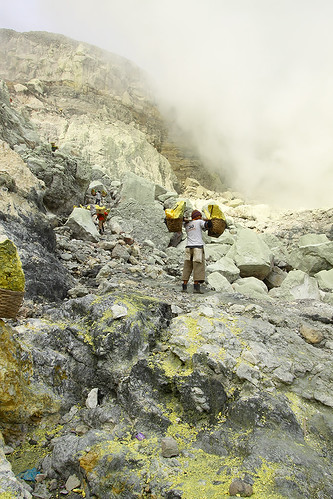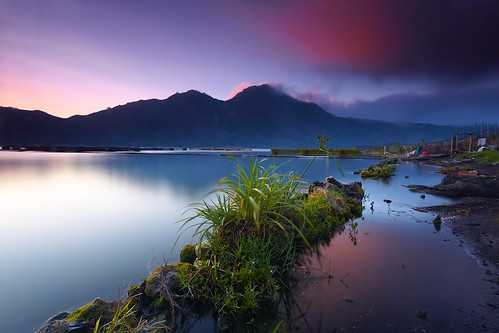
Kawah Ijen (Ijen Crater)
Location: East Java, Indonesia
Coordinates: 8.058°S 114.242°E
Elevation: 2,799 m (9,183 ft)
Type: Stratovolcano
Last eruption: 1999
Approximately 400 volcanoes sit along the Pacific Ring of Fire and from the backbone of Sumatra, Java and Bali. Scientist estimate that between 100-150 of the volcanoes are still active, making up 75percent of all active volcanos on the planet.
Kawah Ijen (Ijen Crater) is a nature reserve Ijen Park is located between Banyuwangi and Bondowoso District, East Java, Indonesia. This crater exactly located at the top of Mount Ijen which is one of a series of volcanoes in East Java such as Raung, Bromo, Semeru and Merapi.
With the elevation 2,799 m (9,183 ft), cold air with temperatures 10° Celsius, the temperature might reach 2° Celsius will increase the sensation of its own experience. Various plants that exist only in the highlands can also be found here.

This beautiful warm crater lake with its blue-greenish water look very inviting but it corrosive and dangerous! Kawah Ijen is the world’s largest highly acidic volcanic lake. The crater size is about 960 meters x 600 meters with a depth of 200 meters is so acidic that it can dissolve clothes and human flesh. The acid measure is almost zero (pH<0.5) about similar to the strength of car battery acid.
Picturesque Kawah Ijen is the world’s largest highly acidic lake and is the site of a labor-intensive sulfur mining operation in which sulfur-laden baskets are hand-carried from the crater floor. In the future they will be a major source of clean geothermal energy, in line with government plans to attract billions of dollars of investment in high-tech power plants.

A hard way of making a living.
In the meantime the miners of Kawah Ijen will extract the volcano’s mineral wealth the only way they know how, with bent backs and bare hands.

The quietly active volcano emits gases through fumaroles inside the crater, and local miners have tapped those gases to earn a living.


Workers repair a sulfur pipe flow, watering to keep it from burning. Nothing has changed here for decades. Nothing is mechanised. The men do everything by hand.


Stone and ceramic pipes cap the fumaroles, and inside, the sulfur condenses into a molten red liquid, dripping back down and solidifying into pure sulfur. Miners hack chunks off with steel bars, braving extremely dangerous gases and liquids with minimal protection, then load up as much as they can carry for the several kilometers to the weighing station.



Price per kilogram solid sulphur is Rp. 600 (less then a dollar), each worker can transport from 70–100 kilograms at once on the abrupt slopes of the volcano, using bamboo ladders where the slope is too steep and must be carried to the crater rim approximately 300 meters above before being carried several kilometers down the mountain. Most miners make this journey twice a day.


One of the problems with improving the men’s situation is that they are all essentially freelance, with no direct employer, so the only safety standards are those the men impose on themselves–which are very few.


After a long hard day, the miners are paid by a nearby sugar refinery by the weight of sulfur transported; as of July 2005 the typical daily earnings were equivalent to approximately $5.00 US per day!
-8.060817
114.237822


























